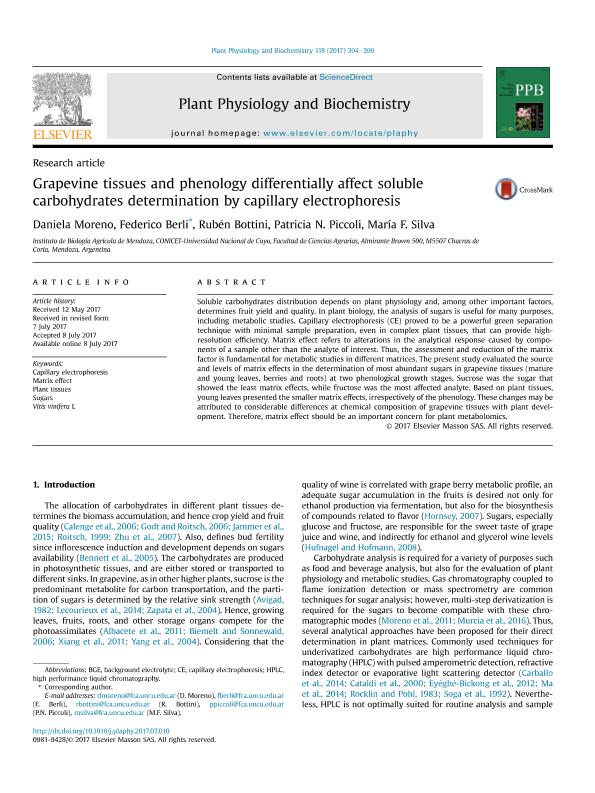Mostrar el registro sencillo del ítem
dc.contributor.author
Moreno, Daniela Maria del Valle

dc.contributor.author
Berli, Federico Javier

dc.contributor.author
Bottini, Ambrosio Rubén

dc.contributor.author
Piccoli, Patricia Noemí

dc.contributor.author
Silva, María Fernanda

dc.date.available
2018-06-19T20:17:21Z
dc.date.issued
2017-09
dc.identifier.citation
Moreno, Daniela Maria del Valle; Berli, Federico Javier; Bottini, Ambrosio Rubén; Piccoli, Patricia Noemí; Silva, María Fernanda; Grapevine tissues and phenology differentially affect soluble carbohydrates determination by capillary electrophoresis; Elsevier France-editions Scientifiques Medicales Elsevier; Plant Physiology and Biochemistry; 118; 9-2017; 394-399
dc.identifier.issn
0981-9428
dc.identifier.uri
http://hdl.handle.net/11336/49455
dc.description.abstract
Soluble carbohydrates distribution depends on plant physiology and, among other important factors, determines fruit yield and quality. In plant biology, the analysis of sugars is useful for many purposes, including metabolic studies. Capillary electrophoresis (CE) proved to be a powerful green separation technique with minimal sample preparation, even in complex plant tissues, that can provide high-resolution efficiency. Matrix effect refers to alterations in the analytical response caused by components of a sample other than the analyte of interest. Thus, the assessment and reduction of the matrix factor is fundamental for metabolic studies in different matrices. The present study evaluated the source and levels of matrix effects in the determination of most abundant sugars in grapevine tissues (mature and young leaves, berries and roots) at two phenological growth stages. Sucrose was the sugar that showed the least matrix effects, while fructose was the most affected analyte. Based on plant tissues, young leaves presented the smaller matrix effects, irrespectively of the phenology. These changes may be attributed to considerable differences at chemical composition of grapevine tissues with plant development. Therefore, matrix effect should be an important concern for plant metabolomics.
dc.format
application/pdf
dc.language.iso
eng
dc.publisher
Elsevier France-editions Scientifiques Medicales Elsevier

dc.rights
info:eu-repo/semantics/openAccess
dc.rights.uri
https://creativecommons.org/licenses/by-nc-sa/2.5/ar/
dc.subject
Capillary Electrophoresis
dc.subject
Matrix Effect
dc.subject
Plant Tissues
dc.subject
Sugars
dc.subject
Vitis Vinifera L
dc.subject.classification
Otras Ciencias Biológicas

dc.subject.classification
Ciencias Biológicas

dc.subject.classification
CIENCIAS NATURALES Y EXACTAS

dc.title
Grapevine tissues and phenology differentially affect soluble carbohydrates determination by capillary electrophoresis
dc.type
info:eu-repo/semantics/article
dc.type
info:ar-repo/semantics/artículo
dc.type
info:eu-repo/semantics/publishedVersion
dc.date.updated
2018-06-13T16:55:06Z
dc.journal.volume
118
dc.journal.pagination
394-399
dc.journal.pais
Francia

dc.description.fil
Fil: Moreno, Daniela Maria del Valle. Consejo Nacional de Investigaciones Científicas y Técnicas. Centro Científico Tecnológico Conicet - Mendoza. Instituto de Biología Agrícola de Mendoza. Universidad Nacional de Cuyo. Facultad de Ciencias Agrarias. Instituto de Biología Agrícola de Mendoza; Argentina
dc.description.fil
Fil: Berli, Federico Javier. Consejo Nacional de Investigaciones Científicas y Técnicas. Centro Científico Tecnológico Conicet - Mendoza. Instituto de Biología Agrícola de Mendoza. Universidad Nacional de Cuyo. Facultad de Ciencias Agrarias. Instituto de Biología Agrícola de Mendoza; Argentina
dc.description.fil
Fil: Bottini, Ambrosio Rubén. Consejo Nacional de Investigaciones Científicas y Técnicas. Centro Científico Tecnológico Conicet - Mendoza. Instituto de Biología Agrícola de Mendoza. Universidad Nacional de Cuyo. Facultad de Ciencias Agrarias. Instituto de Biología Agrícola de Mendoza; Argentina
dc.description.fil
Fil: Piccoli, Patricia Noemí. Consejo Nacional de Investigaciones Científicas y Técnicas. Centro Científico Tecnológico Conicet - Mendoza. Instituto de Biología Agrícola de Mendoza. Universidad Nacional de Cuyo. Facultad de Ciencias Agrarias. Instituto de Biología Agrícola de Mendoza; Argentina
dc.description.fil
Fil: Silva, María Fernanda. Consejo Nacional de Investigaciones Científicas y Técnicas. Centro Científico Tecnológico Conicet - Mendoza. Instituto de Biología Agrícola de Mendoza. Universidad Nacional de Cuyo. Facultad de Ciencias Agrarias. Instituto de Biología Agrícola de Mendoza; Argentina
dc.journal.title
Plant Physiology and Biochemistry

dc.relation.alternativeid
info:eu-repo/semantics/altIdentifier/url/https://www.sciencedirect.com/science/article/pii/S0981942817302322
dc.relation.alternativeid
info:eu-repo/semantics/altIdentifier/doi/http://dx.doi.org/10.1016/j.plaphy.2017.07.010
Archivos asociados
